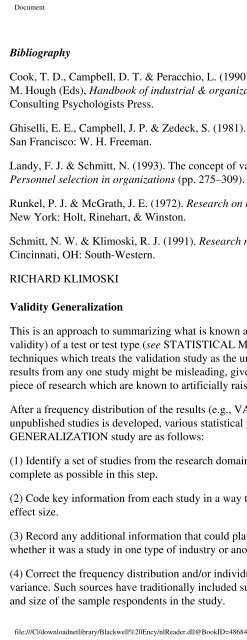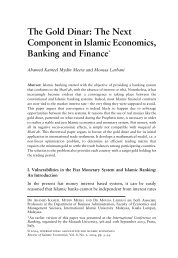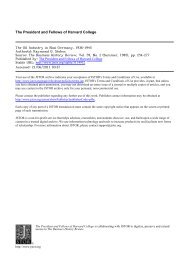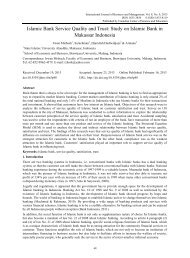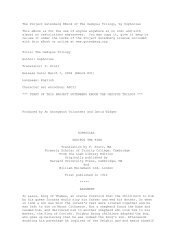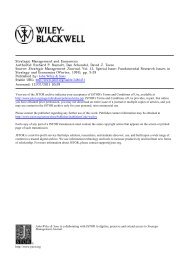- Page 2:
Document The Blackwell Encyclopedic
- Page 6:
Document The Blackwell Encyclopedic
- Page 10:
Document Typeset in 9.5 on 11pt Ehr
- Page 14:
Document Preface Organizational Beh
- Page 18:
Document Page vii all who have shar
- Page 22:
Document current and developing tre
- Page 26:
Document Page ix It is helpful, the
- Page 30:
Document Page x Clearly, to fulfil
- Page 34:
Document Acknowledgments Page xi Th
- Page 38:
Document Contributors Seymour Adler
- Page 42:
Document Adrienne Colella Rutgers U
- Page 46:
Document Daniel C. Feldman Universi
- Page 50:
Document Jerald Hage University of
- Page 54:
Document Kenneth Koput University o
- Page 58:
Document Stella M. Nkomo University
- Page 62:
Document John W. Slocum Southern Me
- Page 66:
Document Edward J. Zajac Northweste
- Page 70:
Document The term can be defined as
- Page 74:
Document The deviance model derives
- Page 78:
Document Goodman, P. S. & Atkin, R.
- Page 82:
Document Dwyer, T. & Raferty, A. E.
- Page 86:
Document Spangler, W. D. (1992). Va
- Page 90:
Document Fryer, D. & Fagan, R. (199
- Page 94:
Document Action Theory can well exp
- Page 98:
Document interdependencies among th
- Page 102:
Document Mood at work has been negl
- Page 106:
Document In all cases we need to as
- Page 110:
Document As part of the wider conce
- Page 114:
Document Support for ARM comes from
- Page 118:
Document See also Exchange relation
- Page 122:
Document Employee Assistance Progra
- Page 126:
Document NIGEL NICHOLSON Altruism T
- Page 130:
Document In ORGANIZATIONAL BEHAVIOR
- Page 134:
Document Some form of assessment ta
- Page 138:
Document Evidence on the criterion-
- Page 142:
Document Gaugler, B., Rosenthal, D.
- Page 146:
Document Attitudes are of interest
- Page 150:
Document Although there are many va
- Page 154:
Document The final assignment of re
- Page 158:
Document Weiner, B. (1986). An attr
- Page 162:
Document In his seminal study of au
- Page 166:
Document These are groups of employ
- Page 170:
Document Autonomy This concept, in
- Page 174:
Document B Bargaining see COLLECTIV
- Page 178:
Document 5. Product Differentiation
- Page 182:
Document See also Conditioning; Inf
- Page 186:
Document During the 1980s and 1990s
- Page 190:
Document Usually, companies benchma
- Page 194:
Document The procedure involves all
- Page 198:
Document Whereas bonus payments for
- Page 202:
Document Bibliography Burns, T. & S
- Page 206:
Document Used in conjunction with m
- Page 210:
Document Compared to modern busines
- Page 214:
Document Bureaucracies are known fo
- Page 218:
Document Economists have asked pers
- Page 222:
Document Simon, H. A. (1976). Admin
- Page 226:
Document The key differences betwee
- Page 230:
Document Still others have focused
- Page 234:
Document Also called ''business pro
- Page 238:
Document C Career Page 44 A career
- Page 242:
Document anchor provides a growing
- Page 246:
Document Page 46 of schemes in term
- Page 250:
Document Holland, J. H. (1985). Mak
- Page 254:
Document Situational Theories Page
- Page 258:
Document Career Plateauing Page 49
- Page 262:
Document Lawrence, B. S. (1988). Ne
- Page 266:
Document reciprocal interaction of
- Page 270:
Document Page 52 The history of car
- Page 274:
Document Howard, A. & Bray, D. W. (
- Page 278:
Document 3 The Management of the Ch
- Page 282:
Document used, which seeks to reduc
- Page 286:
Document See also Generalization; L
- Page 290:
Document organization; and for CEOs
- Page 294:
Document Romanelli, E. & Tushman, M
- Page 298:
Document See also Organizational ef
- Page 302:
Document Focus of Change Efforts Pa
- Page 306:
Document Bibliography Page 61 Argyr
- Page 310:
Document Page 62 observations would
- Page 314:
Document file:///C|/downloadnetlibr
- Page 318:
Document Early results found that t
- Page 322:
Document The most frequently stated
- Page 326:
Document See also Strategic managem
- Page 330:
Document This term refers to the in
- Page 334:
Document Current research in cognit
- Page 338:
Document The theory seeks to accoun
- Page 342:
Document Strategic collaboration wi
- Page 346:
Document The first formal definitio
- Page 350:
Document When there is CONFLICT bet
- Page 354:
Document Webb (1897) coined the ter
- Page 358:
Document Viewed in this longer pers
- Page 362:
Document In their influential work
- Page 366:
Document Bibliography Becker, H. (1
- Page 370:
Document Escalation is the degree t
- Page 374:
Document A major controversy concer
- Page 378:
Document Two functions of communica
- Page 382:
Document variety of language, and p
- Page 386:
Document Communications Technology
- Page 390:
Document New communication technolo
- Page 394:
Document In ecological theories, or
- Page 398:
Document Competencies The word "com
- Page 402:
Document A significant trend is for
- Page 406:
Document Job analysis shows that se
- Page 410:
Document Bibliography Boyatzis, R.
- Page 414:
Document Companies might also diffe
- Page 418:
Document The concept of complexity
- Page 422:
Document Lawrence, P. & Lorsch, J.
- Page 426:
Document CAD systems allow the user
- Page 430:
Document The first methodology for
- Page 434:
Document (a) specification of the b
- Page 438:
Document Is conflict a problem? Muc
- Page 442:
Document Struggles over the allocat
- Page 446:
Document Bibliography Alderfer, C.
- Page 450:
Document Other strategies restructu
- Page 454:
Document There are three fundamenta
- Page 458:
Document (b) the individual's attit
- Page 462:
Document see INTERPERSONAL SKILLS;
- Page 466:
Document Consensus refers to an inf
- Page 470:
Document A typical consulting proce
- Page 474:
Document Future Trends A review of
- Page 478:
Document These dimensions are combi
- Page 482:
Document 5. The extent to which the
- Page 486:
Document Contingency theory was und
- Page 490:
Document Imai, M. (1987). Kaizen: T
- Page 494:
Document Obviously, good INTERPERSO
- Page 498:
Document Williamson (1985), one of
- Page 502:
Document A last type of contract re
- Page 506:
Document Within ORGANIZATIONAL BEHA
- Page 510:
Document Ashford, S. J. & Cummings,
- Page 514:
Document Nonetheless, various obsta
- Page 518:
Document The concept of core compet
- Page 522:
Document The principle of public re
- Page 526:
Document There are a range of possi
- Page 530:
Document Organizational researchers
- Page 534:
Document (c) understanding complexi
- Page 538:
Document The terms crisis and disas
- Page 542:
Document In contrast, Osborn and Ja
- Page 546:
Document WASH-1400, a.k.a., the Ras
- Page 550:
Document Culture is a notoriously d
- Page 554:
Document The literature contains mu
- Page 558:
Document • There should not be mo
- Page 562:
Document relationships to their gro
- Page 566:
Document (b) whether and how the cu
- Page 570:
Document D Decentralization Page 12
- Page 574:
Document sometimes called mixed MEC
- Page 578:
Document Depending on: (1) various
- Page 582:
Document Table 1 The four decision-
- Page 586:
Document Decision making in the are
- Page 590:
Document A similar line of thought
- Page 594:
Document Decision Modeling see COMP
- Page 598:
Document HENRY P. SIMS JR. Delphi T
- Page 602:
Document One alternative is a legal
- Page 606:
Document Closely related to the pro
- Page 610:
Document See also Organizational de
- Page 614:
Document The analysis of dilemmas h
- Page 618:
Document Research concerning person
- Page 622:
Document Goffman, E. (1963). Stigma
- Page 626:
Document Theories of discrimination
- Page 630:
Document Katz, P. & Taylor, D. (198
- Page 634:
Document Another form of related di
- Page 638:
Document More relevant is a micro d
- Page 642:
Document However, in more fragmente
- Page 646:
Document For example, the director-
- Page 650:
Document Second, downsizing usually
- Page 654:
Document Most research to date indi
- Page 658:
Document E Ecology see COMMUNITY EC
- Page 662:
Document extraversion and neurotici
- Page 666:
Document Page 152 Importantly, emot
- Page 670:
Document Bibliography Fineman, S. (
- Page 674:
Document Bibliography Cotton, J. L.
- Page 678:
Document Page 155 Greenberg, J. (19
- Page 682:
Document our understanding of the b
- Page 686:
Document Page 157 for if you wait t
- Page 690:
Document Page 158 these actually pr
- Page 694:
Document Page 159 mixed to date, bu
- Page 698:
Document Page 160 large financial d
- Page 702:
Document When one's own outcome/inp
- Page 706:
Document Page 162 research discipli
- Page 710:
Document Page 163 oping countries i
- Page 714:
Document Page 164 error of the seco
- Page 718:
Document Figure 1 A taxonomy of act
- Page 722:
Document Ethics see BUSINESS ETHICS
- Page 726:
Document van den Berghe, P. (1981).
- Page 730:
Document Evaluation Research Page 1
- Page 734:
Document • the call for ethical c
- Page 738:
Document Page 170 Fombrun, C., Tich
- Page 742:
Document Page 171 utilizing Bartlet
- Page 746:
Document devote more resources to d
- Page 750:
Document Expectancy see VIE THEORY;
- Page 754:
Document F Family Firms Page 174 Al
- Page 758:
Document management systems. Journa
- Page 762:
Document Figure 1 The feedback loop
- Page 766:
Document Use Page 177 Feedback info
- Page 770:
Document attend to and how they wou
- Page 774:
Document high, both suppliers and b
- Page 778:
Document Page 180 positive attribut
- Page 782:
Document Figure 1 Force field diagr
- Page 786:
Document Formal Organization Page 1
- Page 790:
Document According to Schein (1985)
- Page 794:
Document Functional Design Page 184
- Page 798:
Document the most salient aspect of
- Page 802:
Document G Gainsharing Page 186 Thi
- Page 806:
Document Page 187 greater attention
- Page 810:
Document Page 188 receives the amou
- Page 814:
Document Page 189 Von Neumann, J. &
- Page 818:
Document Page 190 who either help t
- Page 822:
Document Page 191 maintained. This
- Page 826:
Document Page 192 joking as intimid
- Page 830:
Document Goal Setting Page 193 This
- Page 834:
Document Page 194 cognition which p
- Page 838:
Document Page 195 The basic questio
- Page 842:
Document Government Agencies Page 1
- Page 846:
Document Figure 1 The main function
- Page 850:
Document Gujarah, D. (1984). Govern
- Page 854:
Document Organizational groups can
- Page 858:
Document 9 The SOCIAL LOAFING effec
- Page 862:
Document Janis, I. L. (1982). Group
- Page 866:
Document Longitudinal studies of WO
- Page 870:
Document Lewin, who once said, "not
- Page 874:
Document Most norms develop gradual
- Page 878:
Document Within the study of GROUP
- Page 882:
Document The relationship between g
- Page 886:
Document Groupthink This term was c
- Page 890:
Document This refers to the strengt
- Page 894:
Document H Halo Effect Page 210 Thi
- Page 898:
Document Page 211 RELIABILITY, VALI
- Page 902:
Document Bibliography Page 212 Roet
- Page 906:
Document 1993; Sackett, Burris, & C
- Page 910:
Document Page 214 seasonal variatio
- Page 914:
Document Page 215 strain) while in
- Page 918:
Document Page 216 promote low, as w
- Page 922:
Document Page 217 A third approach,
- Page 926:
Document Page 218 introduce the bes
- Page 930:
Document Page 219 To understand the
- Page 934:
Document Page 220 influence effecti
- Page 938:
Document Page 221 highly political
- Page 942:
Document Herriot (Eds), Handbook of
- Page 946:
Document Eysenck, H. J. (1960). The
- Page 950:
Document From this perspective an o
- Page 954:
Document Impression management has
- Page 958:
Document (3) Does impression manage
- Page 962:
Document Differences associated wit
- Page 966:
Document The trait approach describ
- Page 970:
Document As Kochan notes (1980, pp.
- Page 974:
Document See also Intergroup relati
- Page 978:
Document Influence also may result
- Page 982:
Document The particular mix of the
- Page 986:
Document Orlikowski, W. J. (1992).
- Page 990:
Document Amabile (1983), Angle (198
- Page 994:
Document The development of this in
- Page 998:
Document The developmental pattern
- Page 1002:
Document The adoption of new ideas
- Page 1006:
Document Innovations originate "som
- Page 1010:
Document JOHANNES M. PENNINGS Insti
- Page 1014:
Document How do organizational prac
- Page 1018:
Document The concept of isomorphism
- Page 1022:
Document Scott, W. R. & Meyer, J. W
- Page 1026:
Document See also Performance, indi
- Page 1030:
Document Intelligence is a broad ba
- Page 1034:
Document Endler, N. S. & Magnusson,
- Page 1038:
Document Interest Groups see POLITI
- Page 1042:
Document between groups. Several ap
- Page 1046:
Document Tajfel, H. (1982). Social
- Page 1050:
Document As most of the industriali
- Page 1054:
Document See also International man
- Page 1058:
Document On the one hand the "conve
- Page 1062:
Document On the other hand, the "cu
- Page 1066:
Document International managers wor
- Page 1070:
Document This is a general term whi
- Page 1074:
Document The third stream of IOR re
- Page 1078:
Document DAVID A. WHETTEN and MARC
- Page 1082:
Document Skills and competencies ar
- Page 1086:
Document 1. Response inspecificity.
- Page 1090:
Document These approaches are not e
- Page 1094:
Document Intrinsic REWARDS are foun
- Page 1098:
Document Introversion see EXTRAVERS
- Page 1102:
Document Quantitative methods allow
- Page 1106:
Document Landy, F. (1993). Job anal
- Page 1110:
Document Fried, Y. & Ferris, G. R.
- Page 1114:
Document In principle, the concept
- Page 1118:
Document Current approaches to job
- Page 1122:
Document Interest in job design whi
- Page 1126:
Document Lawler, E. E. (1992). The
- Page 1130:
Document Certainly taken over a lon
- Page 1134:
Document Establishing Client Relati
- Page 1138:
Document The population of insecure
- Page 1142:
Document This refers to systematica
- Page 1146:
Document Many factors have been hyp
- Page 1150:
Document This refers to the entry a
- Page 1154:
Document Typically, the equity posi
- Page 1158:
Document In JIT, inventory is waste
- Page 1162:
Document See also Advanced manufact
- Page 1166:
Document In attempting to determine
- Page 1170:
Document See also Business ethics;
- Page 1174:
Document A characteristic feature o
- Page 1178:
Document L Labor Markets Page 282 F
- Page 1182:
Document Page 283 theory. Arguably,
- Page 1186:
Document Page 284 He was able to sh
- Page 1190:
Document Leadership is " . . . a pr
- Page 1194:
Document Page 286 COMPLIANCE from s
- Page 1198:
Document above, emphasizing ideolog
- Page 1202:
Document Bass, B. M. (1990). Bass &
- Page 1206:
Document Page 289 leader self-prese
- Page 1210:
Document Page 290 objectives, funct
- Page 1214:
Document higher levels of MOTIVATIO
- Page 1218:
Document Page 292 which experiences
- Page 1222:
Document development (see SELF-REGU
- Page 1226:
Document Page 294 age or experience
- Page 1230:
Document Page 295 we might expect t
- Page 1234:
Document Page 296 Another cross-lev
- Page 1238:
Document Page 297 relatively new. B
- Page 1242:
Document Page 298 and more on later
- Page 1246:
Document Spector, P. E. (1988). Dev
- Page 1250:
Document M Machiavellianism Page 30
- Page 1254:
Document Page 301 provided with pro
- Page 1258:
Document Page 302 H. L. Gantt, whos
- Page 1262:
Document (6) provide FEEDBACK at re
- Page 1266:
Document opportunity to make and im
- Page 1270:
Document Dechant, K. (1990). Knowin
- Page 1274:
Document inception of action learni
- Page 1278:
Document Bibliography Burke, W. W.
- Page 1282:
Document Table 1 Taxonomy of Primar
- Page 1286:
Document edge-based diversity. Team
- Page 1290:
Document Page 311 most concern to t
- Page 1294:
Document Page 312 what is learned i
- Page 1298:
Document the development of talente
- Page 1302:
Document life-time career. The dema
- Page 1306:
Document studies of actual behavior
- Page 1310:
Document Page 316 some of this vari
- Page 1314:
Document Page 317 9, 9 Team Managem
- Page 1318:
Document Page 318 job loss (see RED
- Page 1322:
Document Matrix Organization Page 3
- Page 1326:
Document Page 320 aerospace, invest
- Page 1330:
Document structure but as a frame-o
- Page 1334:
Document on mental health makes the
- Page 1338:
Document Page 323 French, J. R. P.,
- Page 1342:
Document Page 324 vide some but not
- Page 1346:
Document Page 325 Classifications o
- Page 1350:
Document in organizations to learn
- Page 1354:
Document Page 327 uniqueness tales,
- Page 1358:
Document Page 328 4. The minority m
- Page 1362:
Document Moral Development Page 329
- Page 1366:
Document Page 330 Modgil, S. & Modg
- Page 1370:
Document in the work domain. In the
- Page 1374:
Document Page 332 ing and research
- Page 1378:
Document and to persist longer than
- Page 1382:
Document well as other motivational
- Page 1386:
Document Page 335 GROUP DYNAMICS),
- Page 1390:
Document Page 336 Campbell, J. P. &
- Page 1394:
Document file:///C|/downloadnetlibr
- Page 1398:
Document More recently, Kanfer and
- Page 1402:
Document Hygienes (factor 1) refer
- Page 1406:
Document Another definition of the
- Page 1410:
Document Given the increasing impor
- Page 1414:
Document file:///C|/downloadnetlibr
- Page 1418:
Document When two or more parties n
- Page 1422:
Document Research on situational va
- Page 1426:
Document Cognitive The cognitive ap
- Page 1430:
Document MAX H. BAZERMAN Network An
- Page 1434:
Document ALESSANDRO LOMI Networking
- Page 1438:
Document Networking in organization
- Page 1442:
Document The nominal group format i
- Page 1446:
Document Voydanoff (1989) notes tha
- Page 1450:
Document Voydanoff, P. (1989). Work
- Page 1454:
Document Leat, D. (1993). Managing
- Page 1458:
Document At a most basic level are
- Page 1462:
Document The first concerns their h
- Page 1466:
Document As open systems, organizat
- Page 1470:
Document Organizational research or
- Page 1474:
Document The environment is a key c
- Page 1478:
Document CONTINGENCY THEORY takes a
- Page 1482:
Document The RESOURCE DEPENDENCE ap
- Page 1486:
Document SUSAN MILLER Organization
- Page 1490:
Document The emphasis on human fulf
- Page 1494:
Document French, W. L. & Bell, C. H
- Page 1498:
Document The Columbia sociology dep
- Page 1502:
Document At about the same time Oli
- Page 1506:
Document While population ecologist
- Page 1510:
Document Commonly referred to under
- Page 1514:
Document The study of organizationa
- Page 1518:
Document Changes in any of these su
- Page 1522:
Document Many OB scholars have adop
- Page 1526:
Document Unlike life cycle theory,
- Page 1530:
Document In general, a PROCESS THEO
- Page 1534:
Document The paleontologist, Gould
- Page 1538:
Document Occasionally, organization
- Page 1542:
Document Sztompka, P. (1993). The s
- Page 1546:
Document One of its earliest uses w
- Page 1550:
Document Many measures of climate w
- Page 1554:
Document The surface manifestations
- Page 1558:
Document For example, MacDonald (in
- Page 1562:
Document A hierarchical alignment o
- Page 1566:
Document As is the case with Integr
- Page 1570:
Document The methodological choices
- Page 1574:
Document This brief review has expl
- Page 1578:
Document Much research on organizat
- Page 1582:
Document The demography of an organ
- Page 1586:
Document 3 Structure (see STRUCTURA
- Page 1590:
Document The theory of BUREAUCRACY
- Page 1594:
Document Product departmentalizatio
- Page 1598:
Document Perrow's (1970) four types
- Page 1602:
Document A more specific current co
- Page 1606:
Document Underlying the model is th
- Page 1610:
Document March, J. G. (Ed.), (1965)
- Page 1614:
Document Organizational Effectivene
- Page 1618:
Document Certain common approaches
- Page 1622:
Document (4) adapt to the changing
- Page 1626:
Document This paradoxical approach
- Page 1630:
Document Search Routines Models of
- Page 1634:
Document Organizational research ha
- Page 1638:
Document (table continued from prev
- Page 1642:
Document The apparent simplicity of
- Page 1646:
Document P Paradigm Page 401 Confus
- Page 1650:
Document Page 402 EXCELLENCE). Ther
- Page 1654:
Document Page 403 employees persona
- Page 1658:
Document Page 404 advantage (Beaumo
- Page 1662:
Document followers perform dissatis
- Page 1666:
Document behaviors, and ORGANIZATIO
- Page 1670:
Document Page 407 cated payment pla
- Page 1674:
Document Page 408 the form of base
- Page 1678:
Document financial performance. Aca
- Page 1682:
Document Bibliography Arvey, R. & C
- Page 1686:
Document design the job so that peo
- Page 1690:
Document Page 412 mechanisms for FE
- Page 1694:
Document Page 413 tried to measure
- Page 1698:
Document Page 414 the job criteria
- Page 1702:
Document Murphy, K. R. & Cleveland,
- Page 1706:
Document Table 1 Features of pay fo
- Page 1710:
Document This is defined by psychol
- Page 1714:
Document See also Job analysis; Rec
- Page 1718:
Document Within the field of ORGANI
- Page 1722:
Document Personality traits are gen
- Page 1726:
Document 2. Interacting with Other
- Page 1730:
Document Whatever the role assigned
- Page 1734:
Document Using the Big Five model t
- Page 1738:
Document Criteria There are three c
- Page 1742:
Document Gangestad, S. & Snyder, M.
- Page 1746:
Document relationships between the
- Page 1750:
Document Toplis, J., Dulewicz, V. &
- Page 1754:
Document HENRY P. SIMS JR. Politics
- Page 1758:
Document An underlying theme from a
- Page 1762:
Document Examples of political beha
- Page 1766:
Document Finally, such new forms as
- Page 1770:
Document The primary unit of analys
- Page 1774:
Document Why do different forms of
- Page 1778:
Document Organizational Change A co
- Page 1782:
Document Baum, J. A. C. & Mezias, S
- Page 1786:
Document "real" world looks a pale
- Page 1790:
Document Power and INFLUENCE are no
- Page 1794:
Document The uses of power come fro
- Page 1798:
Document The largest barrier to emp
- Page 1802:
Document INDIVIDUAL DIFFERENCES in
- Page 1806:
Document Page 441 derives from two
- Page 1810:
Document organizational structures,
- Page 1814:
Document tions. While its VALIDITY
- Page 1818:
Document Page 444 of noncooperation
- Page 1822:
Document higher national employment
- Page 1826:
Document Page 446 example, how goal
- Page 1830:
Document Process Technology Page 44
- Page 1834:
Document Page 448 What is critical
- Page 1838:
Document Page 449 There have been t
- Page 1842:
Document established professions. C
- Page 1846:
Document Page 451 procedures and ru
- Page 1850:
Document Culture and environment (p
- Page 1854:
Document role of facilitator. They
- Page 1858:
Document Page 454 the magnitudes as
- Page 1862:
Document Whyte, G. (1986). Escalati
- Page 1866:
Document Page 456 other. Rather, th
- Page 1870:
Document Page 457 ING). People may
- Page 1874:
Document analysis from differing pe
- Page 1878:
Document Bibliography Sutton, R. I.
- Page 1882:
Document (2) products, markets, tec
- Page 1886:
Document ated equilibrium paradigm.
- Page 1890:
Document Page 462 organizational se
- Page 1894:
Document Several key questions rema
- Page 1898:
Document The term "quality of worki
- Page 1902:
Document Campbell and Stanley (1966
- Page 1906:
Document Heckman, J. J. & Hotz, J.
- Page 1910:
Document The fact that much of this
- Page 1914:
Document PAUL KOOPMAN Realistic Job
- Page 1918:
Document This term refers to the ph
- Page 1922:
Document More recently, recruitment
- Page 1926:
Document A third area in need of in
- Page 1930:
Document Redundancy involves the lo
- Page 1934:
Document Regulations see BUREAUCRAC
- Page 1938:
Document Page 474 trapped and the r
- Page 1942:
Document Mawhinney, T. C. (1992a).
- Page 1946:
Document Page 476 from PARTICIPATIO
- Page 1950:
Document Page 477 initial investmen
- Page 1954:
Document Page 478 the signals that
- Page 1958:
Document Page 479 services that rai
- Page 1962:
Document Katz, R. & Allen, T. (1985
- Page 1966:
Document in naturalistic settings w
- Page 1970:
Document have the most design stren
- Page 1974:
Document Page 483 well-established
- Page 1978:
Document Page 484 various forms: re
- Page 1982:
Document Obedience; Organizational
- Page 1986:
Document Page 486 (1) that these re
- Page 1990:
Document Page 487 nistic, seeing a
- Page 1994:
Document Page 488 obvious importanc
- Page 1998:
Document Page 489 purview of manage
- Page 2002:
Document munity. Unpublished doctor
- Page 2006:
Document lates in retirement. Journ
- Page 2010:
Document Pay level - A person's job
- Page 2014:
Document Page 493 people in many in
- Page 2018:
Document Bibliography Myers, D. G.
- Page 2022:
Document Page 495 competing, manage
- Page 2026:
Document Page 496 specify many aspe
- Page 2030:
Document Page 497 what each person'
- Page 2034:
Document Bibliography Page 498 Gert
- Page 2038:
Document Role Distancing Page 499 T
- Page 2042:
Document See also Group structure;
- Page 2046:
Document Page 501 The concept of ro
- Page 2050:
Document Commonly held assumptions
- Page 2054:
Document Several authors have focus
- Page 2058:
Document Nichols, T. (1986). Indust
- Page 2062:
Document Overall, the existence of
- Page 2066:
Document Kelly, J. E. (1982). Scien
- Page 2070:
Document Coinciding with the advent
- Page 2074:
Document Wright, P. M., Lichtenfels
- Page 2078:
Document Inferences are made about
- Page 2082:
Document Smith, M. & Robertson, I.
- Page 2086:
Document This condition is the atti
- Page 2090:
Document Self-designing units: Memb
- Page 2094:
Document Many critical intervention
- Page 2098:
Document Sensitivity training gave
- Page 2102:
Document (2) Research also focuses
- Page 2106:
Document Sexual harassment is illeg
- Page 2110:
Document share/equity represents th
- Page 2114:
Document JOYCE C. HOGAN Slack Resou
- Page 2118:
Document (2) the desire for indepen
- Page 2122:
Document This perspective argues th
- Page 2126:
Document This denotes how the prese
- Page 2130:
Document An important, and related,
- Page 2134:
Document Organizational socializati
- Page 2138:
Document One review concluded that
- Page 2142:
Document (2) methods of working sho
- Page 2146:
Document Sociotechnical theory is a
- Page 2150:
Document Figure 1 Relationship betw
- Page 2154:
Document This is defined as the num
- Page 2158:
Document International business org
- Page 2162:
Document Inferential statistics, th
- Page 2166:
Document This is a concept with des
- Page 2170:
Document Status Incongruence This s
- Page 2174:
Document Bierhoff, H. W. (1989). Pe
- Page 2178:
Document See also Mergers and acqui
- Page 2182:
Document Andrews (1980) argued that
- Page 2186:
Document This approach examines how
- Page 2190:
Document At the corporate level, st
- Page 2194:
Document Defenders, Prospectors, An
- Page 2198:
Document Stress There are at least
- Page 2202:
Document • Behavior (ABSENTEEISM;
- Page 2206:
Document Although the popular liter
- Page 2210:
Document This term was coined by Gi
- Page 2214:
Document Substitutes for Leadership
- Page 2218:
Document Succession plans themselve
- Page 2222:
Document Gratton, L. & Syrett, M. (
- Page 2226:
Document A leader is best When peop
- Page 2230:
Document Later study defined the su
- Page 2234:
Document HENRY P. SIMS JR. Surveys
- Page 2238:
Document Organizations use SURVEYS
- Page 2242:
Document Refers to the manipulation
- Page 2246:
Document Swidler, A. (1986). Cultur
- Page 2250:
Document (1) transformation of inpu
- Page 2254:
Document Sutherland, J. (1973). A g
- Page 2258:
Document Task and Maintenance Behav
- Page 2262:
Document Participants in early T gr
- Page 2266:
Document (3) What are we currently
- Page 2270:
Document Several fine distinctions
- Page 2274:
Document Since technology is centra
- Page 2278:
Document The influence of technolog
- Page 2282:
Document Noble, D. (1984). Forces o
- Page 2286:
Document There are common themes be
- Page 2290:
Document Coombs, R., Saviotti, P. &
- Page 2294:
Document Theory and Sensemaking If
- Page 2298:
Document Post-factum interpretation
- Page 2302:
Document Weick, K. E. (1990). The v
- Page 2306:
Document Ouchi, W. G. (1981). Theor
- Page 2310:
Document The term "top management t
- Page 2314:
Document No single authority speaks
- Page 2318:
Document Most of the evidence of TQ
- Page 2322:
Document GERALD E. LEDFORD, JR. Tou
- Page 2326:
Document Although trade unions' beh
- Page 2330:
Document Union government is compos
- Page 2334:
Document When learning events are p
- Page 2340:
Document Needs assessment consists
- Page 2344:
Document Once the tasks, KSAs, and
- Page 2348:
Document example, a survey by Ralph
- Page 2352:
Document Training interventions are
- Page 2356:
Document into the entire process, t
- Page 2360:
Document In addition to the problem
- Page 2364:
Document Cascio, W. F. & Zammuto, R
- Page 2368:
Document This has become one of the
- Page 2372:
Document Before 1980, social and or
- Page 2376: Document Furthermore, there is a hi
- Page 2380: Document In the second definition,
- Page 2384: Document Individuals evidencing hig
- Page 2388: Document This is the active process
- Page 2392: Document • Management often plays
- Page 2396: Document This is defined as volunta
- Page 2400: Document All of the previous approa
- Page 2404: Document Taylor, M. S. & Giannanton
- Page 2408: Document Friedman, M. & Rosenman, R
- Page 2412: Document The concept of uncertainty
- Page 2416: Document Specific factors have been
- Page 2420: Document Fryer, D. (Guest Ed.) (199
- Page 2424: Document V Valence see VIE THEORY V
- Page 2430: Document (5) If necessary or desire
- Page 2434: Document Because values are learned
- Page 2438: Document England, G. W. (1967). Org
- Page 2442: Document These cycles (or circles)
- Page 2446: Document Example: In an employment
- Page 2450: Document Historically, the emphasis
- Page 2454: Document W Withdrawal, Organization
- Page 2458: Document Page 605 omics, anthropolo
- Page 2462: Document Page 606 exploring each to
- Page 2466: Document Reskin, B. & Roos, P. A. (
- Page 2470: Document Bibliography Brenner, O. C
- Page 2474: Document Reimann, B. (1980). Organi
- Page 2478:
Document See also Group dynamics; G
- Page 2482:
Document Page 611 conditions for di
- Page 2486:
Document Index Note: Headwords are
- Page 2490:
Document advanced manufacturing tec
- Page 2494:
Document anthropology, 121 anticipa
- Page 2498:
Document and postmodernism, 436 pow
- Page 2502:
Document research design, 480 selec
- Page 2506:
Document typologies, 48 vocational
- Page 2510:
Document civil rights, 141, 241 cla
- Page 2514:
Document collective action, 71, 112
- Page 2518:
Document community ecology, 82 comm
- Page 2522:
Document and reciprocity, 470 sabot
- Page 2526:
Document and ownership, 13 research
- Page 2530:
Document obedience, 352 teleologica
- Page 2534:
Document business ethics, 41 career
- Page 2538:
Document power, 441 resources, 486
- Page 2542:
Document division of labor, 137, 14
- Page 2546:
Document managerial, 316 organizati
- Page 2550:
Document matrix organization, 319 o
- Page 2554:
Document evolutionary theory, organ
- Page 2558:
Document performance appraisal, 413
- Page 2562:
Document Follett, M. P., 63 force f
- Page 2566:
Document roles, 516 sexual harassme
- Page 2570:
Document groupthink, 207 quality ci
- Page 2574:
Document gate keepers, 189 group de
- Page 2578:
Document conflicts, 95 and discrimi
- Page 2582:
Document influence, 231 group dynam
- Page 2586:
Document empirical results, 241 gua
- Page 2590:
Document importance, 257 training,
- Page 2594:
Document job satisfaction, 2, 9, 75
- Page 2598:
Document knowledge of results, 280,
- Page 2602:
Document social constructionism, 52
- Page 2606:
Document management development, 30
- Page 2610:
Document management of high potenti
- Page 2614:
Document and analysis levels, 294 r
- Page 2618:
Document human relations movement,
- Page 2622:
Document innovation, 239 interorgan
- Page 2626:
Document team building, 555 organiz
- Page 2630:
Document demography, 383 differenti
- Page 2634:
Document organizational neurosis, 3
- Page 2638:
Document performance appraisal, 413
- Page 2642:
Document research, 481 performance,
- Page 2646:
Document phenomenology, 228 plannin
- Page 2650:
Document power, 5, 24, 437 autonomy
- Page 2654:
Document process technology, 447, 5
- Page 2658:
Document Q quality, 87, 393, 476 se
- Page 2662:
Document research integrative view,
- Page 2666:
Document resource partitioning, 432
- Page 2670:
Document business ethics, 41 stakeh
- Page 2674:
Document training, 577 selection in
- Page 2678:
Document payment systems, 406 perso
- Page 2682:
Document social loafing, 200, 206,
- Page 2686:
Document international management,
- Page 2690:
Document strategy implementation, 5
- Page 2694:
Document symbolic architecture, 67
- Page 2698:
Document job characteristics, 264 j
- Page 2702:
Document tit-for-tat, 443 top manag
- Page 2706:
Document uncertainty, 592 avoidance
- Page 2710:
Document shared, 599 socialization,
- Page 2714:
Document life stages, 297 paid work
- Page 2718:
Document Y Yin, R. K., 483 file:///


